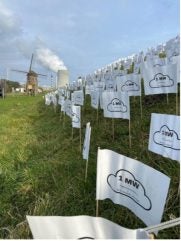
Unit 1 of Belgium’s Doel NPP, a 445 MWe (net) pressurised water reactor (PWR), has been taken offline after 50 years of operation and disconnected from the grid. Operator Electrabel, the Belgian subsidiary of France’s Engie, said: “In the coming days, the operators will cool down the reactor in a controlled manner and lower the pressure in the primary cooling circuits to the level of the ambient air pressure. As soon as the plant has cooled down sufficiently, the unloading of the nuclear reactor can begin. In this process, the fuel rods are lifted out of the reactor one by one and transferred to separate docks, where they will continue to cool under water for several years.”
Belgium has seven nuclear power reactors – three at Tihange near Liège and four at Doel near Antwerp. All seven units are pressurized water reactors (PWRs) operated by Electrabel. Apart from Doel 1&2, which are 450 MWe plants, the others have a capacity of approximately 1000 MWe. Doel 3 was permanently shut down in September 2022 followed by Tihange 2 in January 2023 after 40 years of operation, in line with Belgium’s 2003 nuclear phase-out policy.
However, earlier in February, Belgium’s new coalition government outlined plans to continue operating Doel 4 and Tihange 3 for another 10 years, beyond the 10-year extension already agreed, and to construct new reactors, effectively reversing phase out plans.
The federal law requiring the phase-out of all nuclear electricity generation originally scheduled Doel 1 for closure on its 40th anniversary in February 2015. However, the law was amended in 2013 and 2015 allowing Doel 1 to continue operating for an additional ten years. According to the law, unit 1 of the Tihange plant is set to shut in October this year followed by Doel 2 in December. Doel 4 and Tihange 3 – are scheduled to close in November 2035.
However, the closure of Doel 1 met with protests and in view of the new policy the closures of Tihange 1 and Doel 2 may now be reconsidered.
A nuclear inspector from Belgium’s Federal Agency for Nuclear Control (FANC) oversaw the shutdown of Doel 1. “Technically, there is no difference with a normal shutdown for maintenance, except that the reactor will no longer be used to produce electricity after the final shutdown,” FANC said.
FANC noted that Doel 1&2 are twin reactors, which means they share certain components. These include many safety systems and a shared control room and machine room. “The first shutdown activities for Doel 1 will start in the coming weeks,” it said. “Because Doel 2 will continue to operate … some of the shutdown activities will only take place when both reactors are no longer in use.”
FANC explained that the shutdown process begins with the ‘shutdown notification’ that the reactor operator submits for approval describing the activities that will be carried out after the shutdown to prepare the installation for dismantling. These include the removal of used fuel for cooling in the used fuel pools, and the removal of operational waste. Pipes that are no longer needed are flushed and emptied. All this takes about five years.






